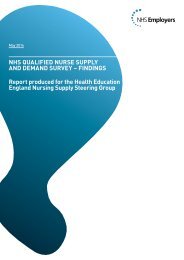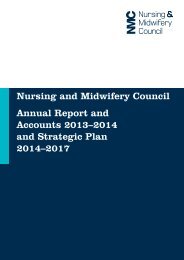Journal_1_2014_final_WEB
Journal_1_2014_final_WEB
Journal_1_2014_final_WEB
Create successful ePaper yourself
Turn your PDF publications into a flip-book with our unique Google optimized e-Paper software.
Eating problems, Shopping and Cooking problems<br />
(SCALES); Global Subjective Assessment; Malnutrition<br />
Universal Screening Tool (MUST), Mini Nutritional<br />
Assessment (MNA); and Nutrition Risk<br />
Screening 2002 (NRS 2002).<br />
The NRS 2002 is recommended for use in hospitals,<br />
whereas the MUST tool is intended for general use.<br />
The MNA is the only tool validated in Spanish.<br />
The third subsection presents key scientific evidence<br />
for the role of nutrition in chronic wound prevention<br />
and treatment, examining mechanisms underlying<br />
physiological and metabolic processes. Topics<br />
include energy intake; protein and/or specific amino<br />
acid intake and fatty acid intake and their potential<br />
immunomodulatory effects; liquid intake; and<br />
intake of micronutrients (zinc, iron, copper, alpha<br />
lipoic acid, and vitamins A, C, K, and E). A section<br />
focuses on nutritional interventions and their role<br />
in wound prevention and treatment.<br />
The conclusion highlights the important role of<br />
nutrition in wound care, emphasising that nutritional<br />
screening and assessment have been, thus far,<br />
overlooked in the field of wound research. Although<br />
substantial scientific evidence is beginning to appear<br />
in this field, further research is needed.<br />
3. Recommendations for clinical practice. Recommendations<br />
are presented with the level of supporting<br />
evidence based on the Grading of Recommendations<br />
Assessment, Development and Evaluation<br />
(GRADE) Working Group guidelines. Recommendations<br />
take into account questions that clinicians<br />
should ask such as: When should nutritional status<br />
be assessed? Who should assess nutritional status?<br />
How should nutritional risk be assessed? Which nutritional<br />
interventions can prevent and treat chronic<br />
wounds?<br />
4. Recommendations for researchers. Recommendations<br />
are presented to provide researchers<br />
with guidance in fields for which further research<br />
is needed.<br />
This document therefore provides a broad analysis<br />
of this topic and identifies existing gaps in knowledge<br />
of the relationships among nutritional status,<br />
nutritional interventions, and wound management.<br />
<br />
m<br />
WOUND CARE<br />
IN THE ONE<br />
HEALTH PERSPECTIVE<br />
Symposium<br />
on Veterinary<br />
Wound Management<br />
and Antimicrobial<br />
Resistance<br />
EWMA n GNEAUPP <strong>2014</strong> Conference<br />
Madrid, Spain<br />
14 May <strong>2014</strong> · 13:00 -17:30<br />
n What can veterinary wound care learn from<br />
human wound care and vice versa?<br />
n How can modern wound care contribute to<br />
combatting the increasingly urgent problem of<br />
antimicrobial resistance?<br />
These are some of the questions that will be<br />
debated at the 1st Symposium on Veterinary<br />
Wound Management and Antimicrobial<br />
Resistance.<br />
This symposium is relevant for practitioners,<br />
researchers and other health professionals<br />
from the veterinary and human health sectors.<br />
We are looking forward to seeing you!<br />
EWMA <strong>Journal</strong> <strong>2014</strong> vol 14 no 1




